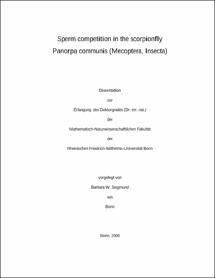Siegmund, Barbara W.: Sperm competition in the scorpionfly Panorpa communis (Mecoptera, Insecta). - Bonn, 2007. - Dissertation, Rheinische Friedrich-Wilhelms-Universität Bonn.
Online-Ausgabe in bonndoc: https://nbn-resolving.org/urn:nbn:de:hbz:5N-09484
Online-Ausgabe in bonndoc: https://nbn-resolving.org/urn:nbn:de:hbz:5N-09484
@phdthesis{handle:20.500.11811/3045,
urn: https://nbn-resolving.org/urn:nbn:de:hbz:5N-09484,
author = {{Barbara W. Siegmund}},
title = {Sperm competition in the scorpionfly Panorpa communis (Mecoptera, Insecta)},
school = {Rheinische Friedrich-Wilhelms-Universität Bonn},
year = 2007,
note = {The aim of the present study was to investigate the basal mechanism of sperm competition in the European scorpionfly Panorpa communis. Within three laboratory experiments, I used five newly developed microsatellite markers to detect the mechanism of sperm competition in the scorpionfly P. communis.
In general, sperm competition occurs if sperm of different males compete for the fertilisation of the ova of one female. As P. communis females mate multiple with different males and store sperm in a storage organ until fertilisation, there is sperm competition in this species. To clarify the outcome of sperm competition, paternity detection of offspring of a multiple mated female is necessary. The most practicable way for paternity detection is the application of microsatellite markers. As a first step of my work, I established five new markers to achieve species specific microsatellites for P. communis.
Then, I arranged two experiments in order to detect the mechanism of sperm competition, Here, females were paired to two or three different males, respectively. Since copulation duration, generally, is known to be a good estimator for the number of transferred sperm, I was able to draw conclusions from the proportion of sperm a male contributed to the spermatheca of the female in relation to rival males. I was able to show that the outcome of sperm competition is not influenced by the mating order of males. Consequently, any form of last male sperm precedence for P. communis could be excluded. But, paternity patterns were influenced by copulation duration and therefore by the proportion of sperm represented in the spermatheca. Both experiments conclude that, in P. communis, sperm of different males is mixed and compete numerically for fertilisations, i.e. there is a fair raffle in sperm competition.
In a further experiment, I analysed if sperm transfer rates of different males are equal. Although, males were slightly different respective their sperm transfer rates, these differences did not influence the outcome of sperm competition. Accordingly, using copulation duration as a general estimator for the number of transferred sperm is possible.
Finally, I discussed the role of sperm competition for scorpionflies in general and, how it may be maintained in this group. Furthermore, I hypothesised how the remarkable mating system in combination with different sperm competition mechanisms in scorpionflies may have evolved.},
url = {https://hdl.handle.net/20.500.11811/3045}
}
urn: https://nbn-resolving.org/urn:nbn:de:hbz:5N-09484,
author = {{Barbara W. Siegmund}},
title = {Sperm competition in the scorpionfly Panorpa communis (Mecoptera, Insecta)},
school = {Rheinische Friedrich-Wilhelms-Universität Bonn},
year = 2007,
note = {The aim of the present study was to investigate the basal mechanism of sperm competition in the European scorpionfly Panorpa communis. Within three laboratory experiments, I used five newly developed microsatellite markers to detect the mechanism of sperm competition in the scorpionfly P. communis.
In general, sperm competition occurs if sperm of different males compete for the fertilisation of the ova of one female. As P. communis females mate multiple with different males and store sperm in a storage organ until fertilisation, there is sperm competition in this species. To clarify the outcome of sperm competition, paternity detection of offspring of a multiple mated female is necessary. The most practicable way for paternity detection is the application of microsatellite markers. As a first step of my work, I established five new markers to achieve species specific microsatellites for P. communis.
Then, I arranged two experiments in order to detect the mechanism of sperm competition, Here, females were paired to two or three different males, respectively. Since copulation duration, generally, is known to be a good estimator for the number of transferred sperm, I was able to draw conclusions from the proportion of sperm a male contributed to the spermatheca of the female in relation to rival males. I was able to show that the outcome of sperm competition is not influenced by the mating order of males. Consequently, any form of last male sperm precedence for P. communis could be excluded. But, paternity patterns were influenced by copulation duration and therefore by the proportion of sperm represented in the spermatheca. Both experiments conclude that, in P. communis, sperm of different males is mixed and compete numerically for fertilisations, i.e. there is a fair raffle in sperm competition.
In a further experiment, I analysed if sperm transfer rates of different males are equal. Although, males were slightly different respective their sperm transfer rates, these differences did not influence the outcome of sperm competition. Accordingly, using copulation duration as a general estimator for the number of transferred sperm is possible.
Finally, I discussed the role of sperm competition for scorpionflies in general and, how it may be maintained in this group. Furthermore, I hypothesised how the remarkable mating system in combination with different sperm competition mechanisms in scorpionflies may have evolved.},
url = {https://hdl.handle.net/20.500.11811/3045}
}






